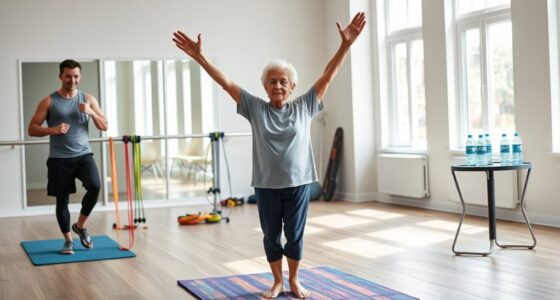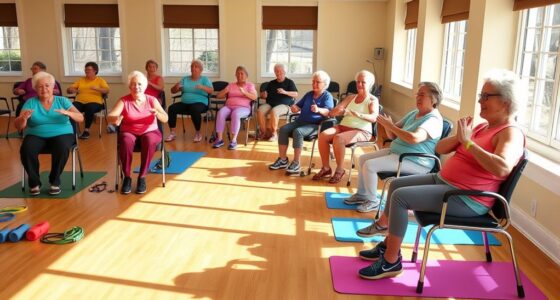Staying active is key to your health and well-being as you age. Aim for at least 150 minutes of moderate-intensity exercise weekly, like brisk walking, and include muscle-strengthening activities twice a week. Balance exercises also play an essential role in reducing fall risks. Regular physical activity boosts your mood, enhances mobility, and can even sharpen your memory. Discovering community resources and specialized programs can help you stay motivated and thrive every day in your wellness journey.
Key Takeaways
- Engage in at least 150 minutes of moderate-intensity aerobic activity weekly, such as brisk walking, to maintain cardiovascular health.
- Incorporate muscle-strengthening exercises two days a week to enhance overall strength and functionality.
- Include balance exercises three times a week to improve stability and reduce the risk of falls.
- Break long periods of inactivity with light activities to boost health and well-being.
- Join community programs for tailored exercise opportunities and social support in staying active.
The Importance of Staying Active

Staying active is essential for your overall health as you age, since regular physical activity can greatly lower your risk of chronic diseases like heart disease and diabetes.
For older adults, the health benefits of exercise extend beyond just physical well-being. Engaging in 150 minutes of moderate-intensity exercise weekly helps maintain your independence and enhances cognitive function, preserving your memory as you age. Regular activity can also help mitigate the effects of emotional instability that some older adults may experience due to mental health conditions. Additionally, incorporating seniors texting humor into your social interactions can further enhance your mental well-being. Furthermore, personal development strategies can empower you to stay motivated and consistent in your exercise routine. Participating in outdoor activities can also connect you with nature, promoting a slower, more fulfilling lifestyle.
Additionally, regular physical activity strengthens your muscles and bones, reducing the risk of falls and osteoporosis. Staying active also boosts your mood, alleviating symptoms of depression and anxiety. Furthermore, understanding financial considerations for elderly care can help you access resources that support your active lifestyle.
Recommended Physical Activity Guidelines
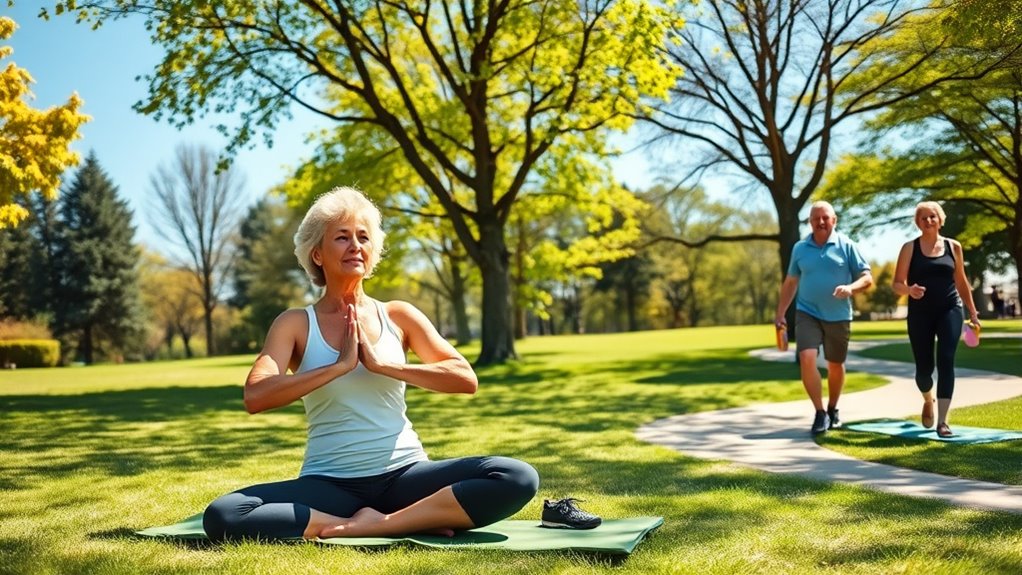
To stay healthy and independent, you should aim for at least 150 minutes of moderate-intensity aerobic activity each week. Incorporating muscle-strengthening and balance exercises into your routine is just as important for enhancing strength and preventing falls. Regular physical activity can also help reduce symptoms associated with sundowner syndrome, promoting better mental health and well-being. Additionally, engaging in physical activity can improve cognitive function and overall brain health, which are essential for maintaining independence as you age. Consistently practicing high vibrational energy during your workouts can further enhance your overall well-being and vitality. Regular exercise also supports emotional regulation, helping you manage stress and improve mood. Furthermore, incorporating predictive modeling into your fitness routine can help tailor your activity plans to better suit your individual health needs. Let’s explore the specifics of these activity guidelines and how they can fit into your lifestyle.
Weekly Activity Recommendations
Older adults should aim for at least 150 minutes of moderate-intensity aerobic activity or 75 minutes of vigorous-intensity exercise each week. Following these weekly activity recommendations helps you reap significant health benefits. Additionally, incorporating high-protein breakfasts can support muscle recovery after workouts. For instance, options like Egg Rollup and Dumpling Sauce provide a quick and protein-rich start to the day.
In addition to aerobic activities, incorporate muscle-strengthening exercises at least two days a week, targeting major muscle groups to enhance strength and mobility. Understanding your risk tolerance regarding exercise intensity is crucial for safety. Don’t forget to include balance exercises three times weekly to improve stability and reduce fall risk. It’s also essential to break long periods of inactivity; any movement counts. Gradually building up to these recommended levels can lead to ideal health outcomes, making your daily life more vibrant and fulfilling. Additionally, maintaining a proper diet rich in fruits and vegetables can further support overall health and enhance the benefits of physical activity.
Types of Exercise
Engaging in a variety of exercises is essential for maintaining overall health as you age. To meet the physical activity guidelines, aim for at least 150 minutes of moderate-intensity aerobic activity weekly, like brisk walking. Incorporate muscle-strengthening activities on two or more days to enhance strength and combat frailty. Regular participation in physical activities can also reduce anxiety and depression symptoms associated with cognitive decline. Additionally, many older adults benefit from routine health checks to ensure their health is monitored and any issues are addressed promptly. Balance exercises, performed at least three times a week, can help reduce the risk of falls. Additionally, utilizing mindfulness and relaxation techniques can support your emotional well-being as you stay active. Adopting a growth mindset can also motivate older adults to embrace new physical activities and remain engaged in their health journey.
Here’s a quick overview of essential types of exercise:
| Type of Exercise | Recommended Frequency |
|---|---|
| Aerobic Activity | 150 minutes moderate or 75 minutes vigorous weekly |
| Muscle Strengthening | 2 or more days per week |
| Balance Exercises | At least 3 times per week |
| Flexibility and Stretching | Regularly, as needed |
Incorporating these types of exercise can greatly improve your activity level and overall quality of life.
Types of Physical Activity: Light, Moderate, and Vigorous
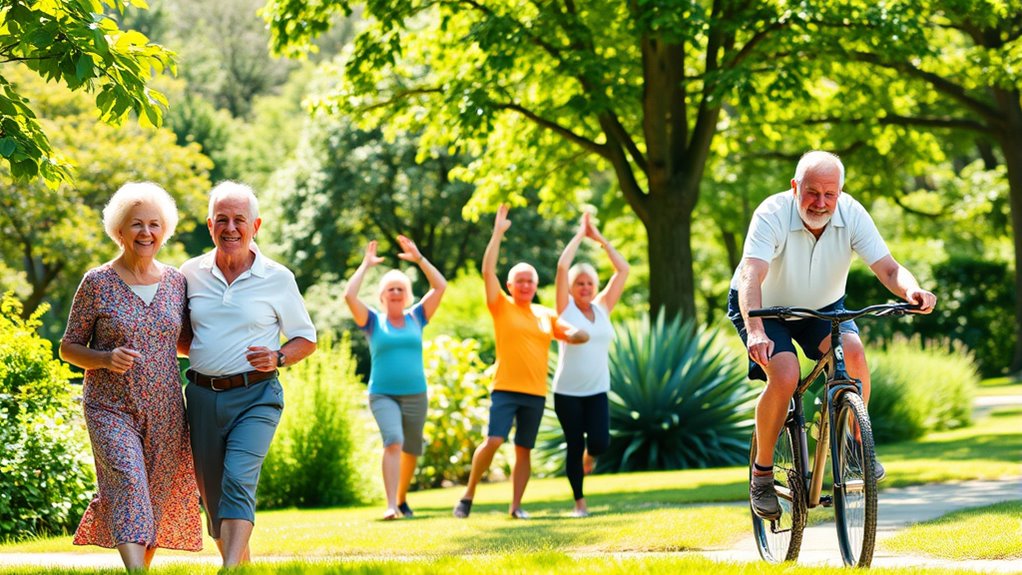
Understanding the different types of physical activity can greatly enhance your fitness journey as you age.
Light activity, like slow walking or cleaning, helps break long periods of inactivity and boosts your overall health, similar to how awareness of narcissistic behaviors is crucial for self-protection in relationships. Engaging in outdoor activities can also provide both physical benefits and fresh air.
Moderate-intensity activities, such as brisk walking or water aerobics, elevate your heart rate while allowing for conversation; aim for at least 150 minutes weekly.
Aim for at least 150 minutes of moderate-intensity activities weekly to elevate your heart rate while still enjoying conversation.
On the other hand, vigorous-intensity activities, like running or swimming, require heavy breathing and limit conversation, with a goal of 75 minutes weekly for similar benefits.
Incorporating balance exercises into your routine is also essential.
Together, these light, moderate, and vigorous activities create a well-rounded fitness regimen, improving your health and independence as you grow older. Additionally, engaging in regular physical activity can significantly enhance your overall well-being and reduce the risk of chronic diseases.
Muscle-Strengthening Activities for Seniors
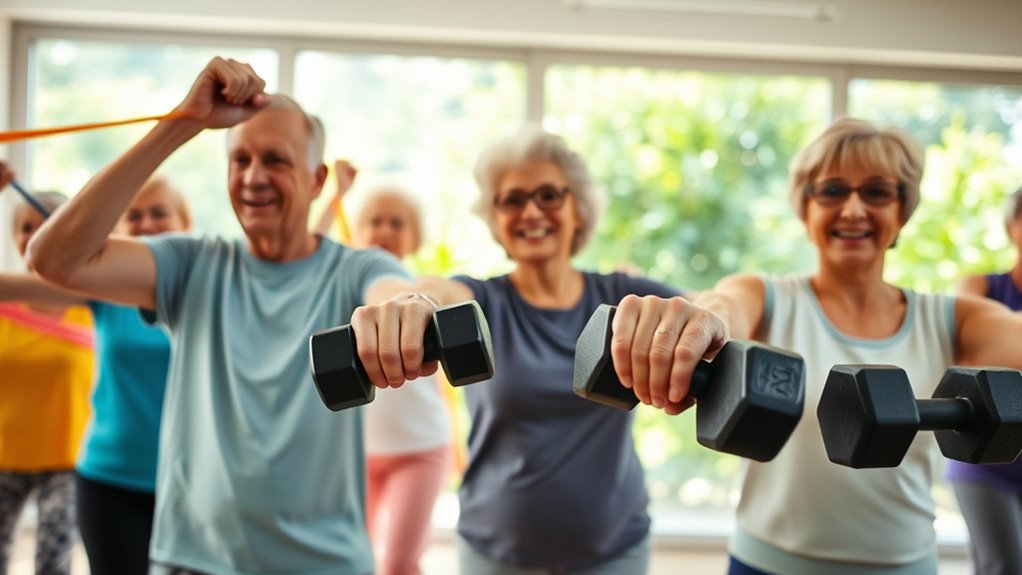
Strength training is essential for maintaining your strength and functionality as you age.
By focusing on safe exercise techniques, you can enhance your balance and mobility, which helps reduce the risk of falls.
Let’s explore some effective muscle-strengthening activities that you can easily incorporate into your routine.
Importance of Strength Training
As you age, muscle-strengthening activities become essential for maintaining your overall health and independence.
Strength training offers numerous benefits for active older adults, helping to improve your mobility and reduce the risk of falls.
Here are three key reasons to incorporate strength training into your routine:
- Enhanced Balance: Strength training improves coordination, making daily activities safer and easier.
- Increased Muscle Mass: Regular workouts combat the natural decline in muscle, allowing you to maintain functional ability.
- Mental Health Benefits: Engaging in muscle-strengthening activities can reduce symptoms of depression and anxiety, promoting overall well-being.
Aim for at least two days a week, targeting major muscle groups, to experience these health benefits and thrive each day!
Safe Exercise Techniques
When it comes to safely engaging in muscle-strengthening activities, knowing the right techniques can make all the difference in your workout experience. Aim to perform exercises at least twice a week, targeting major muscle groups. Incorporate body weight, resistance bands, or dumbbells to improve strength. Don’t forget to combine these activities with aerobic exercises for thorough fitness.
Here’s a quick guide on safe muscle-strengthening techniques:
| Technique | Benefits | Tips |
|---|---|---|
| Body Weight Exercises | Builds functional strength | Start with simple movements |
| Resistance Bands | Enhances flexibility | Control the resistance |
| Dumbbells | Improves overall strength | Focus on form, not weight |
| Yoga | Increases balance and mobility | Choose beginner-friendly poses |
Consult a healthcare professional to create a personalized plan that suits your needs.
Benefits of Regular Exercise
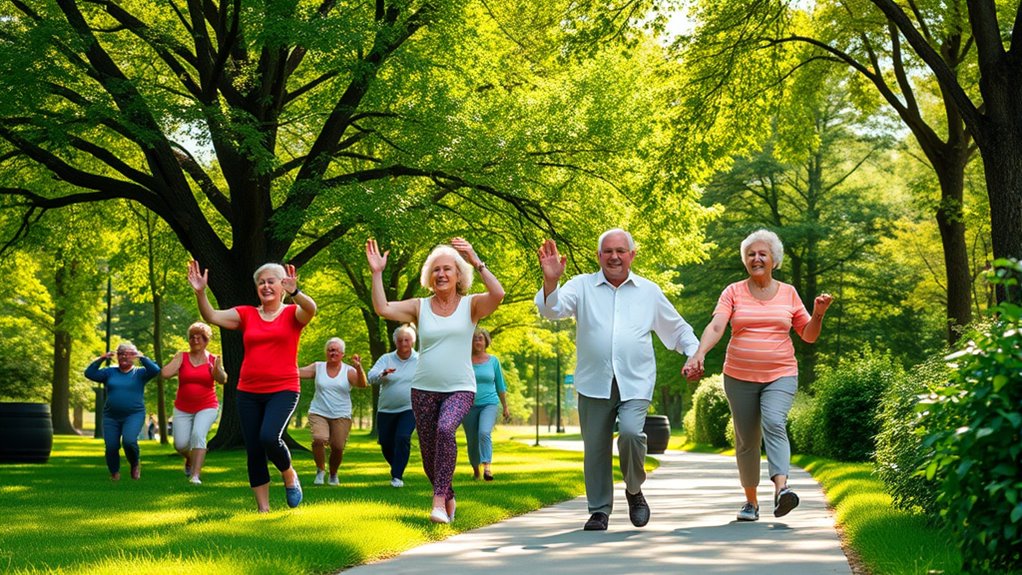
Regular exercise offers a multitude of benefits that can profoundly enhance your quality of life as you age. Staying active isn’t just about physical health; it can greatly improve your overall well-being.
Here are three key benefits:
- Disease Prevention: Regular activity reduces the risk of chronic diseases like heart disease and diabetes, contributing to better health and longevity.
- Cognitive Enhancement: Engaging in exercise boosts cognitive function and helps preserve memory, mitigating the mental health effects of aging.
- Mood Improvement: Physical activity can lift your mood and reduce symptoms of depression and anxiety, promoting a more positive outlook on life.
Community Resources and Support

Finding community resources and support can greatly enhance your fitness journey as an older adult. Many community programs provide tailored exercise opportunities that promote physical activity and health improvement.
Organizations like the National Council on Aging connect you with effective programs designed specifically for older adults. Look for evidence-based classes like EnhanceFitness and Geri-Fit in your area, which focus on strength, flexibility, and balance.
Additionally, federal funding sources help support these initiatives, making it easier for you to engage in activities. Joining local fitness groups fosters a sense of community and provides the encouragement you need to stay active.
Specialized Programs for Fall Prevention

As you age, participating in specialized programs for fall prevention can make a significant difference in your overall safety and confidence.
Engaging in these programs enhances your balance and promotes physical activity, which is crucial for maintaining independence.
Here are three effective options to evaluate:
- Tai Chi for Arthritis: This program improves movement, balance, and flexibility while reducing pain and fall risk.
- Tai Ji Quan: Moving for Better Balance®: Focuses on functional exercises that enhance balance and mobility, providing evidence-based fall prevention strategies.
- Walk with Ease: Develop a personalized walking plan that increases physical activity, manages pain, and promotes safe exercises.
These programs not only help you stay active but also provide essential health education to keep you informed and safe.
Tips for Staying Motivated and Active

To stay motivated and active, it’s essential to set realistic fitness goals that you can achieve, like aiming for at least 150 minutes of moderate-intensity activity each week.
Make sure to incorporate a variety of exercises, including aerobic, strength, and balance activities, to keep things interesting. Engaging in social walking or group exercise classes tailored for older adults can also enhance enjoyment and commitment to your daily routine.
Using a step counter or fitness app helps monitor your activity levels, encouraging consistency. Don’t forget to break up long periods of inactivity with small movements throughout the day; even light activities can help improve your overall health.
Embrace the benefits of staying active, and you’ll thrive every day!
Frequently Asked Questions
What Activities Should Older Adults Do to Stay Active?
To stay active, you should aim for at least 150 minutes of moderate aerobic activities each week, like brisk walking or swimming.
Incorporate muscle-strengthening exercises twice a week, using resistance bands or doing push-ups.
Don’t forget balance exercises, such as tai chi, three times a week to improve stability and reduce fall risks.
Finally, engage in light daily activities, like walking or cleaning, to keep yourself moving and reduce sedentary time.
What Is the Most Beneficial Exercise for Seniors?
You know how they say, “Walking is the best medicine”? Well, for seniors, it’s truly one of the most beneficial exercises.
It’s low-impact, easy to do, and requires no fancy equipment. By walking regularly, you improve your cardiovascular health, strengthen your muscles, and boost joint mobility.
Plus, pairing it with muscle-strengthening and balance activities creates a powerful routine that enhances your overall health and quality of life.
What Is the Number One Exercise When You Get Older?
The number one exercise when you get older is walking. It’s a low-impact activity that you can easily fit into your daily routine.
Aim for at least 150 minutes a week, breaking it down into shorter sessions if needed. Brisk walking strengthens your muscles, helps manage weight, and improves joint health.
Plus, walking with friends or in groups makes it more enjoyable, boosting your motivation to stay active and independent.
What Exercise Should a 70 Year Old Do Every Day?
Imagine your body as a well-tuned instrument, needing daily practice to keep it in harmony.
As a 70-year-old, you should incorporate light activities every day. Think brisk walking, gardening, or even dancing in your living room. These movements keep your joints flexible and your spirits high.
Aim for balance exercises a few times a week too, like tai chi, to enhance stability and reduce fall risks.
Conclusion
Staying active might seem intimidating, but the rewards far outweigh the effort. While a cozy chair calls your name, imagine the strength and energy waiting for you outside. Embrace the challenge of movement, and you’ll discover a world where each step brings joy and connection. Remember, it’s not just about adding years to your life; it’s about adding life to your years. So, choose to thrive every day, and let your spirit soar!


